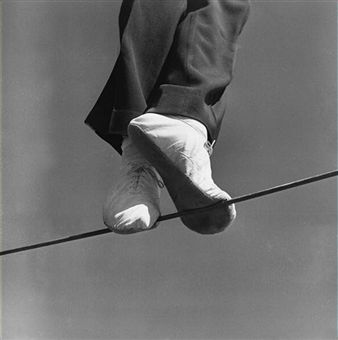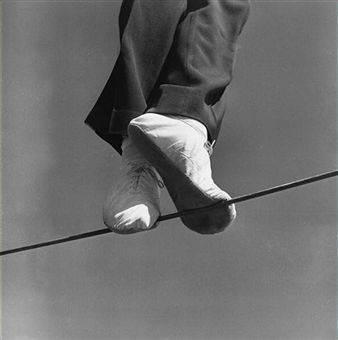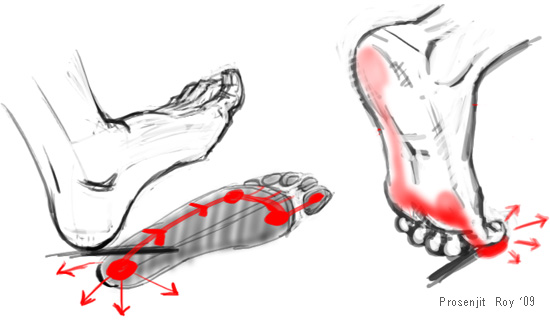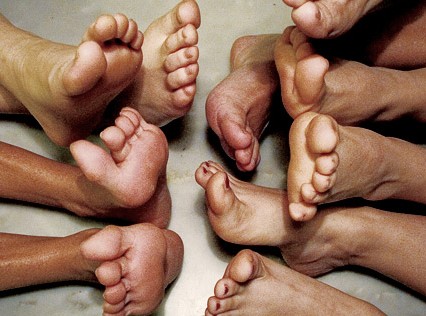
Improving Movement Accuracy with Barefoot Science
 For a dancer, athlete, surgeon or pilot – precision of movement is crucial to the success of their career. Even the slightest deviation in movement accuracy can have devastating ramifications – not just to themselves but also others.
For a dancer, athlete, surgeon or pilot – precision of movement is crucial to the success of their career. Even the slightest deviation in movement accuracy can have devastating ramifications – not just to themselves but also others.
Although the demands of the above movements may not apply to all of us, can we still take the concept of movement accuracy and apply it to our everyday lives?
Absolutely!
Movement Accuracy & Overuse Injuries
Everyday in my office I am presented with patients experiencing foot pain such as Achilles tendonitis, plantar fasciitis and stress fractures – all injuries I associate with poor control of impact forces and an inaccuracy in movement patterns.
The inaccuracy in movement patterns I am referencing is in their gait, or walking.
As the second most common subconscious activity we do daily (besides breathing) the demands and movement accuracy needed for walking are often taken for granted. All too often the interaction between foot and ground is not appreciated and is overlooked by patients.
Potential Energy & Impact Forces
Often referred to as a series of controlled falls, walking should require very little external energy. With each step w e take gravity is accelerating our swing leg forward into initial contact or heel strike.
e take gravity is accelerating our swing leg forward into initial contact or heel strike.
Upon heel contact 1 – 1.5x our body weight in impact forces enter our body in less than 50 milliseconds. This rapid input of impact forces is designed to be damped or absorbed by the body, stored as potential energy and released as elastic energy.
Due to the rapid acceleration of impact forces the only way the body can effectively load this potential energy is if the ground is anticipated. If we wait for the foot to strke the ground to react to the impact forces – it is already too late.
Delayed loading response can lead to movement inaccuracy, compensation patterns and injury.
Movement Anticipation
Movement accuracy is deeply linked to movement anticipation or pre-programmed motor responses set to known movement patterns. Often referred to as feed forward or pre-activation responses these motor patterns are stored in the cerebellum and are based on past experiences.
Imagine if we were able to walk and anticipate the ground and the impact forces before each heel strike? How would this impact our injury risk?
If we begin to anticipate the ground we would be able to load impact forces faster and more effectively. We would be able to improve the accuracy of our movement patterns and reduce our risk of overuse or impact-related injury.
Improving Movement Accuracy
When it comes to improving movement accuracy the biggest concept here is that our movement patterns are only as good as the information we bring into our nervous system.
Bad movement patterns create movement inaccuracy.
When it comes to walking and the loading of impact forces, one of the biggest contributors to movement inaccuracy is our shoes.
With the plantar foot containing of thousands of highly sensitive mechanoceptors any barrier between the ground and the skin on the bottom of the foot will alter the accuracy of information coming into the nervous system.
The accuracy of impact force rate and intensity will be altered. The accuracy of foot placement and perception of surface compliancy will be altered. Ultimately the risk of injury will be higher.
Enter Barefoot Training
 Part of my prescription I give patients every day is to integrate barefoot stimulation into their daily routine. This may be as simple as barefoot trigger point release first thing in the morning. Or it may be 5 minutes of barefoot movement prep before a run.
Part of my prescription I give patients every day is to integrate barefoot stimulation into their daily routine. This may be as simple as barefoot trigger point release first thing in the morning. Or it may be 5 minutes of barefoot movement prep before a run.
Whatever the technique the benefit of getting out of the shoes and stimulating the nervous system from the ground up cannot be expressed enough. Want to kick it up a notch – these are my favorite #barefootstrong tips:
- Plantar foot stimulation – 5 minutes 2x a day and before working out
- Short foot activation – 5 minutes 2x a day and before working out
- Barefoot balance exercises – 5 minutes before working out and 30 minutes 2x a week
For videos demonstrating the above exerices please click HERE
To learn more about how to become #barefootstrong please check out my book Barefoot Strong: Unlock the Secrets to Movement Longevity available HERE
